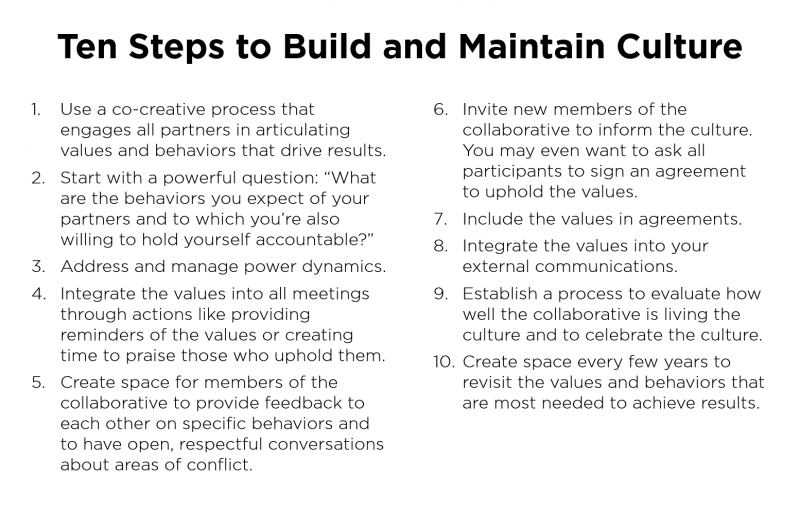We’ve all witnessed the importance of culture in organizations. Many leaders have seen their efforts fall apart because their team wasn’t aligned or power dynamics impeded their progress. On the other hand, others have been part of teams that built such a deep sense of trust that they took greater risks and ultimately achieved greater change.
Culture can speed up or slow down progress because, at the end of the day, we’re complex humans working with other complex humans. These same dynamics are at play in collaborative efforts such as collective impact initiatives. If we want to be successful at collective impact, stakeholders must define and tend to a shared culture across the collaborative.
While many of us can attest to the importance of culture from our experience working inside organizations, our research at Community Wealth Partners backs it up. When we examined various transformational initiatives that involved multiple stakeholders, including the anti-malaria movement and anti-smoking movement, in every instance, an intentional culture emerged as a necessary element in achieving dramatic change. And though each culture will be unique, the cultures in these change-making initiatives shared several characteristics:
- A focus on outcomes
- Transparency
- Authenticity
- Collaboration and partnership
- Equity and inclusion
- Continuous learning and improvement
- Openness to risk and change
Whether your collective is newly formed or has worked together for years, you can take concrete steps to build, strengthen and maintain culture.
How to Build Culture in a Collective
Culture is defined as the “way we do things around here” or, more formally, the values (what we care about) and behaviors (specific actions to live out the values) that guide how we interact. Explicitly stating values and behaviors can help inform a group’s decisions and how individuals interact with each other. It can prove particularly important in moments of tension, grounding groups in shared values and helping them productively work through conflict.
A first step in getting intentional about culture is to start a conversation about what core values guide the group’s collaboration. You’ll want just a few values, ideally no more than five. The clearer and more concise they are, the easier they will be for members of the collective to remember. For example, one of the Arizona Early Childhood Alliance’s values is “respectful dialogue”—it’s short, sweet and easy to recall.
The next step is determining how these values can be lived out through behaviors. While many groups recognize the importance of clarifying their values, few articulate associated behaviors. Yet getting detailed on what, exactly, collaborative members can do to live out values is crucial to turning lofty ideas into clear action. When articulating behaviors, make sure to keep the group’s broader goals in mind and tie behaviors to the outcomes you’re seeking. Group members might start a discussion about behaviors by asking themselves: What are the behaviors I expect of my partners and to which I’m also willing to hold myself accountable? One of the ways the Arizona Early Childhood Alliance wanted to demonstrate their value of “respectful dialogue” was to “seek first to understand and then to be understood.” Aligning on these behaviors is important, but perhaps even more critical is building commitment among all group members to hold themselves and each other accountable to them.

Adapted from the Stanford Social Innovation Review article “Cocreating a Change-Making Culture.”
These conversations provide a great opportunity to address power dynamics, which can limit a group’s progress. Power dynamics inevitably exist—between funders and grantees or around race, gender, sexual orientation, ability, socioeconomic status and other identities. As a group, discuss structures that might help you recognize, equalize and manage power dynamics. For example, the Kauffman Foundation’s Early Education Funders Collaborative adopted a one-vote policy in which all funders, regardless of the size of their grant, would have the same decision-making power. Other collaboratives have created shared-leadership structures and rotating leadership roles.
How to Maintain Culture
Culture-building isn’t a task or onetime project. You must continually nurture culture and revisit it. It helps to create mechanisms to recognize when the culture is being lived out and when the group falls short. This might include shout-outs in meetings where team members recognize moments in which they’ve seen each other uphold the values or a space for team members to share feedback with each other. The culture will be tested as the group welcomes new members, shifts its strategies and responds to new dynamics. As new members join the collective, you’ll also want to give them an opportunity to shape and commit to the culture. It also helps to revisit the behaviors and ensure they’re leading to the collaborative’s desired results. We’ve found it helpful to go through the process of revisiting values and behaviors as often as every three years.
When it comes down to it, culture is often seen as a nice-to-have, yet we believe culture is critical if a group hopes to truly transform communities. To make the change we seek through collective impact initiatives, we have to do the hard and rewarding work of co-creating a strong culture.
For more resources on culture, take a look at the SSIR article “Cocreating a Change-Making Culture,” the Grantmakers for Effective Organizations Culture Resource Guide and the Collective Impact Forum blog post The Culture of Collective Impact by Paul Schmitz.
Have questions or comments? Share them below.
